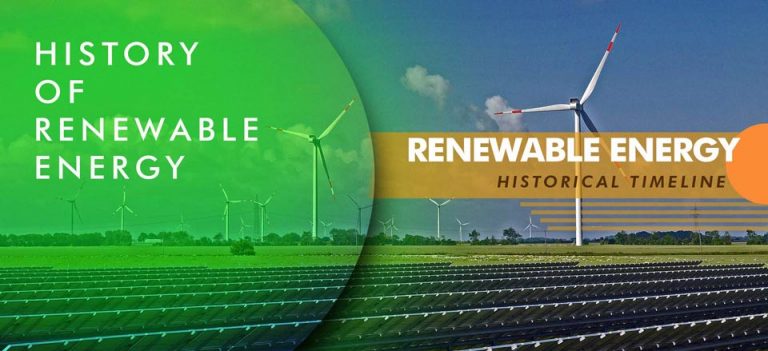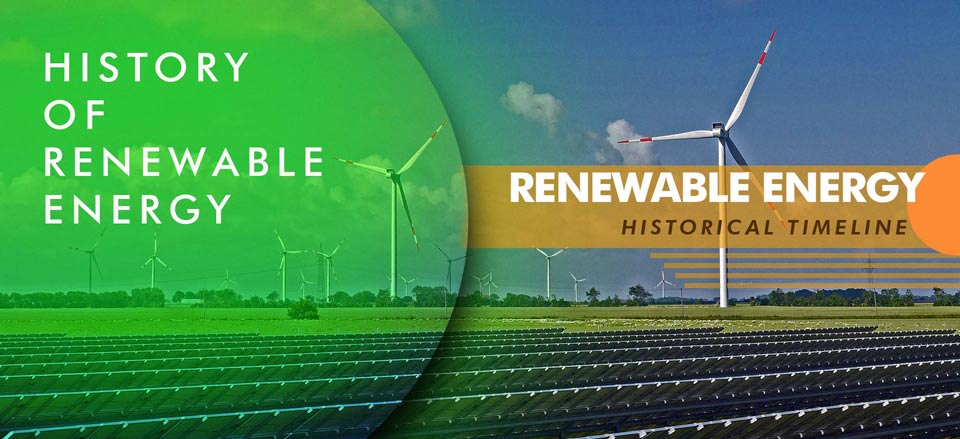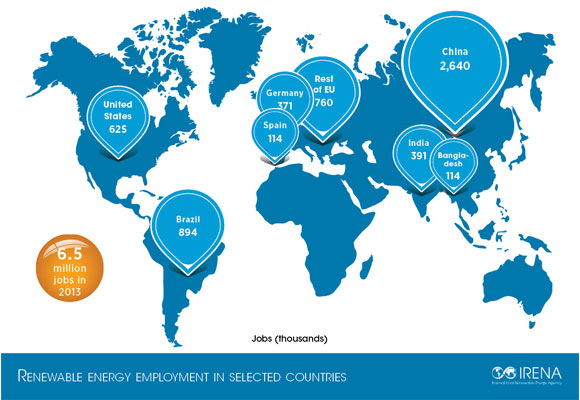
Want to know how renewable energy came in? Bored with opening many tabs for the collecting information? No worries! Get a brief and organized historical review or timeline on the renewable energy era by era.

Along with the types of renewable energy, significant advantages, and many more.
So stay with us!!
You can quickly get a brief about why renewable energy is so important and in what ways renewables can contribute to sustainability and how these clean energy sources impact on the environment.
The importance of sustainability is the core goal of current generations comes at the cost of limited use of fossil fuels and efficient use of renewable power, which you’ll find here in brief and easy words.
Before starting to Brief History of Renewable Energy. Let’s have a quick overview of Renewable energy.
What is Renewable Energy? Why its called Green Energy?
If described simply, renewable energy is the energy that is extracted or used from any naturally occurring processes, can be replenished and thus, is theoretically inexhaustible even if used up without limits on a human time scale. For example, Solar energy is renewable as sunlight never exhausts.
Other names given to renewable energy are ‘green energy”, ‘sustainable or eco-friendly energy’ due to the positive environmental aspects of renewable energy compared to non-renewable energy. Harnessing energy from renewables does not require emitting greenhouse gases responsible for global warming and extracting fossil fuels at an alarming rate while simultaneously being an option to combat climate change.
Types of Renewable Energy Sources :
8 Major sources of renewable energy are:

- Bio-energy
- Geothermal
- Hydroelectric
- Solar
- Wind
- Ocean
- Hydrogen
- Tidal
Why Renewable Energy is so important nowadays?
To ensure sustainability is the main highlight of renewable energy from an ecological point of view. Along with this, many other important aspects can be discussed:
- resort to the global threat of energy scarcity as it is inexhaustible
- a feasible option for energy security for future generations is a competitive market at present
- an important platform for all nations pledging to reduce global emissions within 1.5 degrees according to the Paris Agreement to combat climate change
- stable energy prices
- economic benefits in the long run
- safe public health worldwide
- Reduced energy dependence
Brief History of Renewable Energy Era by Era :
Though renewable energy was used naturally, for example, sun radiating heat for functioning the ecosystem services, the use of renewable energy needed to be mechanized along with human civilization. With baby steps like identifying solar energy to be embedded in fossil fuels and using it for lighting (9000 years ago), humans developed the use of renewable energies, although not optimum till now. The timeline of the history of renewable energy can be divided into the following six phases:
- 2000BC-1499: Chinese developed natural gas as an option for renewables while Europeans start using waterwheels in power mills as used by Philon (around 225BC) ultimately decreasing human and animal muscle power and increasing productivity
- 1500-1799: Enormous windmills developed by the Dutch at its fullest possible degrees acting as a chief agent for land reclamation and generating power
- 1800-1899: First natural gas well installed in the U.S to uptake natural gas while the windmills operated water pumps to alleviate the problem of water shortage in the western U.S, reaching up to six million in number as traced by authorities. In 1882, we witnessed the installation of a first hydroelectric power plant in Appleton, Wisconsin, for private and commercial customers. The windmill to generate power solely was invented in 1888 by Charles F.Brush
- 1900-1950: Theories of photoelectric effect explained by Albert Einstein, studies of Ethanol as a better option than fossil fuels led to the development of renewable energy technologies. Development of world’s largest hydroelectric plant, The Hoover Dam in Colorado River, Arizona, world’s first large scale solar thermal plant installation in California, construction of Acts from the judiciary in the energy sector, all these were some remarkable steps taken in this period
- 1951-1999: first commercial wind turbines sold to remote farmers to generate power, first nuclear power reactor built in Idaho, first US satellite to use solar power are some of the highlights from this period while the world suffered from a massive Chernobyl nuclear explosion and Largest oil spill in the USA
- 2000-present: IPCC report revealed the anthropogenic reasons to dominate the climate change, American recovery and reinvestment act pledges billions of dollars for energy sector, world’s largest concentrated power generation plant (Ivanpah), withdrawal of investments from fossil fuels by 800 global investors in 2014, New Mexico commits to go for 100% renewable energy by 2050.
Summaries the timeline of Renewable Energy :
If renewable energy is traced back, we get the burning of wood for cooking and other purposes, bringing the concept of nonrenewable sources in the very beginning.
Again, the oil used for lighting brought the idea of solar energy stored in the form of fossil fuels (9000 years ago). Wind energy was used for sailing ships in the Mediterranean region (5000 years ago) After the European Renaissance, and the world felt the urgency of power-operated devices in industrialization as fueled by the slave free Europe. This is how it came along.
In the research field of renewables, Baltimore inventor Clarence Kemp first patented a commercial water heater in 1891, which got the spotlight after physicist Albert Einstein discovered photoelectric effect and published a paper.
Since renewable energy supply is unlimited, can be replenished and used for an uncountable number of times, it can be concluded as infinite. However, the endless demand for renewable energy can be harmful because of all the included costs or economic aspects that come along with the technical issues. It is the system price or value, which is often overlooked in the discussion.
As human civilization advanced, the sources of renewable energy were the only available energy until the middle of the 18th century, but it all changed after the Industrial Revolution when fossil fuels began to be exploited.
For the next 200 years, fossil fuels reigned the energy sector.
However, the drastic change in climate as a result of global warming awakened humans about the environmental impact of the burning of fossil fuels. Moreover, a huge demand for energy resulted in diminishing fossil fuels inside the earth.
As a result, attention went back to renewable power to commercialize as a viable option for sustainability.
Present energy consumption of Renewable Energy :
Today, global renewable energy consumption reaches up to 16,893.54 TWh of all renewable energies combined.
Nearly 200 countries pledging to cut down emissions for a global temperature below 2 degrees are investing in renewable energy and thus increasing the use of renewable electricity even on a domestic scale.
Doubling the renewable energy share mix up to 36% by 2030 will add a growth of 1.3 trillion dollars to the global economy, the well being of 3.7% and employment opportunities of 24 million people compared to 9.2 million people employed today according to International Renewable Energy Agency (IRENA)
From the realization of the importance of renewable energies to the development of technologies, humans have come a long way to harness energy as much as possible, but there are many more challenges. In developing nations, the renewable energy sector is dominated by donations from international funds with a few of the installations operating properly and them being economically viable. Decentralization is crucial here due to the difference in typical unit sizes or local energy technologies. The energy storage problem should carefully be addressed.
How Renewable energy Impact on Job sector?
Employment opportunities generated by the renewable energy sector are vast.
- In 2016, the solar energy industry employed more than 26,000 people.
- hydroelectric plants employed about 66,000 people in 2017.
- the geothermal industry employed over 5800 people, and
- the wind energy industry employed 100,000 people in the U.S alone in 2016.
According to a study from concerned scientists, renewable industry give job opportunities three times more than that provided by fossil fuels.

Renewable energy also solve the problem of varying market prices to a great extent. Thus, looking at all the advantages renewables can be considered as a viable option both ecologically and commercially.
A significant barrier to switching to renewable energy includes insufficient economic capacities of many countries compared to energy demands, dependency on weather and natural systems, waste management, lack of country-specific equipment designs, expensive setup and supporting systems, lack of information dissemination to the public.
Final Thought :
After over viewing the history of renewable energy, now its time to wrap the article with some recommendations.
Although renewables are still to be explored and commercialized in an available form, it is no longer a niche sector promoted by governments or environmentalists.
Significant international investments, public concern for environmental consequences, high oil prices; all these factors are driving elements developing the renewable energy sector.
The fact that coal deposits will deplete within the next 200 to 300 years and petroleum deposits will deplete as well brings us to the emergence of the renewable energy sector to combat the global threat.
Environmental conservation through renewable energy becomes clear if we look at the statistics of emissions and thus give us an idea about the importance.
Burning natural gas for electricity emits 0.6-2 pounds of C02/Kwh and coal emits 1.4-3.6 pounds of CO2E/Kwh
While electricity generated by
- Wind energy emits only 0.02-0.04 pounds of CO2E/Kwh
- Solar energy generates 0.07-0.2 pounds of CO2E/Kwh
- Geothermal energy generates 0.1-0.2 and
- Hydroelectric generates 0.1-0.5 pounds of C02E/Kwh only.
While fossil fuels have significant impacts on water, solar, or wind do not necessarily require water to operate and thus do not exploit water resources. Although hydroelectric, biomass and geothermal plants disrupt water ecosystems; there is a possible chance of lessening the impact in the future with high renewables, according to NREL’s renewable energy study.
To know about the history of renewable energy is not enough, we also recommend to adopt this clean and green energy as soon as possible for the seek of energy consumption along with the pollution-free environment.